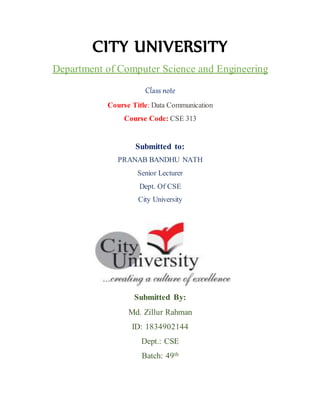
Notes on Class 3
- 1. CITY UNIVERSITY Department of Computer Science and Engineering Class note Course Title: Data Communication Course Code: CSE 313 Submitted to: PRANAB BANDHU NATH Senior Lecturer Dept. Of CSE City University Submitted By: Md. Zillur Rahman ID: 1834902144 Dept.: CSE Batch: 49th
- 2. Notes on Class 3 OSI Model: The OSI model is a layered framework for the design of network systems that allows communication between all types of computer systems. It consists of seven separate but related layers, each of which defines a part of the process of moving information across a network. Seven layers of OSI model: PhysicalLayer: The physical layer is responsible for the physical cable or wireless connection between network nodes. It defines the connector, the electrical cable or wireless technology connecting the devices, and is responsible for transmission of the raw data, which is simply a series of 0s and 1s, while taking care of bit rate control.
- 3. Data Link Layer: The data link layer establishes and terminates a connection between two physically-connected nodes on a network. It breaks up packets into frames and sends them from source to destination. This layer is composed of two parts—Logical Link Control (LLC), which identifies network protocols, performs error checking and synchronizes frames, and Media Access Control (MAC) which uses MAC addresses to connect devices and define permissions to transmit and receive data. Network Layer: The network layer has two main functions. One is breaking up segments into network packets, and reassembling the packets on the receiving end. The other is routing packets by discovering the bestpath across a physical network. The network layer uses network addresses (typically Internet Protocoladdresses)to route packets to a destination node. TransportLayer: The transportlayer takes data transferred in the sessionlayer and breaks it into “segments” on the transmitting end. It is responsible for reassembling the segments on the receiving end, turning it back into data that can be used by the sessionlayer. The transportlayer carries out flow control, sending data at a rate that matches the connection speed of the receiving device, and error control, checking if data was received incorrectly and if not, requesting it again.
- 4. SessionLayer: The session layer creates communication channels, called sessions, between devices. It is responsible for opening sessions, ensuring they remain open and functional while data is being transferred, and closing them when communication ends. The session layer can also set checkpoints during a data transfer—if the sessionis interrupted, devices can resume data transfer from the last checkpoint. PresentationLayer: The presentation layer prepares data for the application layer. It defines how two devices should encode, encrypt, and compress data so it is received correctly on the other end. Thepresentation layer takes any data transmitted by the application layer and prepares it for transmission over the session layer. Application Layer: The application layer is used by end-user software suchas web browsers and email clients. It provides protocols that allow software to send and receive information and present meaningful data to users. A few examples of application layer protocols are the Hypertext Transfer Protocol(HTTP), File Transfer Protocol(FTP), PostOfficeProtocol(POP), Simple Mail Transfer Protocol (SMTP), and Domain Name System (DNS). Analog Signals: The analog signals were used in many systems to producesignals to carry information. These signals are continuous in both values and time. The use of analog signals has been declined with the arrival of digital signals. In short, to
- 5. understand analog signals –all signals that are natural or come naturally are analog signals. Digital Signals: Unlike analog signals, digital signals are not continuous, but signals are discrete in value and time. These signals are represented by binary numbers and consist of different voltage values.
- 6. Frequency: Frequency is the rate of change with respect to time. Change in a short span of time means high frequency. Change over a long span of time means low frequency. Phase:The term phase describes the position of the waveform relative to time O. If we think of the wave as something that can be shifted backward or forward along the time axis, phase describes the amount of that shift. It indicates the status of the first cycle. Wavelength: Wavelength is another characteristic of a signal traveling through a transmission medium. Wavelength binds the period orthe frequency ofa simple sine wave to the propagation speed of the medium. Reference: Book: Data Communication and Networking By Behrouz A.Forouzan https://www.imperva.com/learn/application-security/osi-model https://byjus.com/physics/difference-between-analog-and-digital